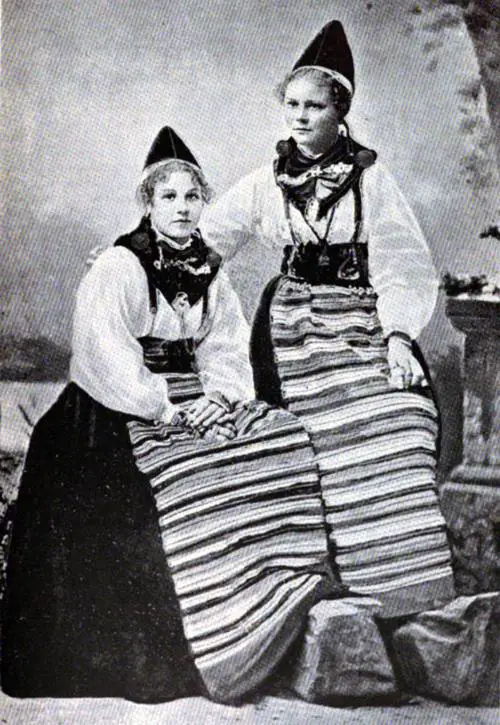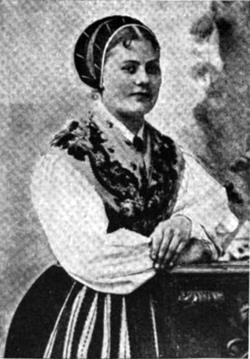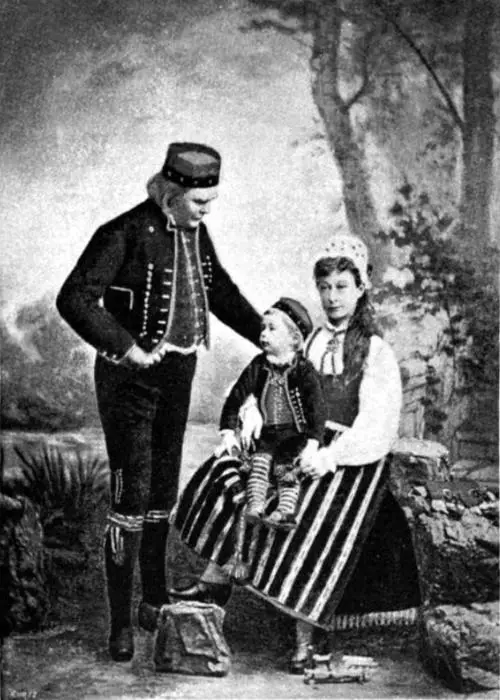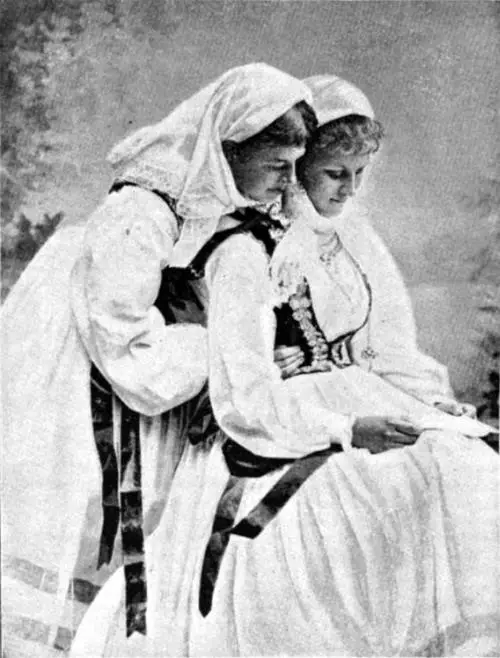Folk Costumes from Dalarna, Sweden
It was a pleasant July evening as we steamed away from Stockholm through the wide thoroughfare by Furusund, and I lingered long on deck in the bright Northern twilight enjoying the beautiful views of luminous water reaches, dotted with dark spruce-crowned isles.

There was not much to see in the morning except a long, low line of woods seemingly growing out of the water and extending on our port hand as far as the eye could reach.
As to the beauty of the landscape, one might as well coast along the shores of North Carolina. These low strands are characteristic of the Gulf of Bothnia and stretch their monotonous length to its northernmost cove.
What a contrast to the lofty Norwegian Fjords which tower a mile above the sea on the west coast of the Scandinavian Peninsula. I was altogether glad when we steamed in between the long, wooden jetties where the Dal River poured into the gulf and exchanged the boat Gefle for the city of the same name.
The first view of Gävle, coming from the Bothnia, is not prepossessing. You see only a significant number of high lumber piles. The lumber is pine and spruce, bright yellow in color, and regularly piled in great squares, and so high as to entirely conceal the city which lies beyond.
When once you have got into Gävle you will be pleased with its wide, regular streets and its great square paved market-place, where burly peasant women, standing behind their little wagons, strive to sell you anything from a fat cheese to a pair of warm woolen stockings.
Moreover, I scarcely know of a more delightful stroll than you can make in the long, thickly-wooded park by the banks of Gävle stream, which pours tumbling, sparkling and foaming through the green wood, and brings into this city park the wildlife of its remote source among the hills.
It was ten P.M. when I entered Falun, but the ruddy sunset was burning on the red brick church tower and there on the north wall it would burn through all the night.
Falun is the capital of Dalarna, and the seat of the vast copper mines that have been worked no one knows how long, certainly for more than five hundred years.
After a late supper, I took a walk to the outskirts of the town. Here a magnificent hillside slanted upwards, black and barren, one great mass of slag from the mines, reeking and smoking out of the "roasting hills," piled up like a black eruption over its surface.
The scene reminded me of the vast fields of cooling lava one sees on the sides of Mount Vesuvius, or of the smoldering ruins of a burned city. Every tree and bush and blade of grass had been killed off by the fumes of smelting copper, and nothing was left but the "abomination of desolation."
The proper thing to do at Falun is to go down into the mines, but the desolation of Kopparberg so oppressed my soul that I made my escape by the earliest train on the morrow.
The resemblance of the scenery of Sweden to that of the State of Maine is particularly striking along the road toward Lake Siljan.
The ravines we crossed reminded me strongly of those on the upper St. John River, and the valley of the Dal from Djura to Insjön, called vividly to mind the valley of the Madawaska River, just across the northern border of my native State.
There was the same long, green, level valley, bordered by low wooded hills on either side and intersected by the bright rippling river. However, these low nestling hamlets strewn over the interval were surely not the homes of Americans.
In the hayfield stood Hässja, across whose rails the newly-cut grass was being laid to dry. The mowers were clad in green waistcoats, across which their red shirtsleeves waved to and fro as they swung their scythes.
Broad-faced peasant women in close-fitting red caps, roomy, puffed-out white sleeves and dress fronts striped horizontally with many colors, were raking the hay or carrying it in armfuls to the Hässja, while boys in long greenish-yellow coats, which gave them the appearance of little old men, sported about and did not seem to be doing anything in particular.
The railroad ended at Insjön, and we continued our journey up the Dal River on board the little brown steamer Oslerdalarne. Among the passengers was a middle-aged, medium-sized, solid-looking man, with handsome features, and pleasant, intelligent expression.
He was clad in a white, short coat, light-colored buckskin breeches tied about the knee, long white woolen stockings, and low shoes with large buckles of silver.
He also wore a long leather apron like that of a blacksmith, only this was fresh and clean, reaching from breast to ankles, strapped over his shoulders, and tied about his waist.
Dropping into conversation with him, I soon learned he was no other than Brows Olaf Larsson, one of the largest landowners and most influential men of Dalarna.
There is only one other in the province so potent as he, and that is the tall, impressive-looking vice-speaker of the lower house of the Swedish Riksdag, who comes down to Stockholm to the meeting of the Swedish Congress, in the costume of his parish, with his hair parted in the middle, and cut so as to hang at even length all around his massive head.
He is one of the celebrities of Stockholm. You will not pass a week there in the winter without seeing him, and you will be sure to ask who he is. The answer will be, Liss Olof Larsson.
It is a little singular that these two uncrowned kings of Dalarna should have the same name, Olof Larsson; for Bröms and Lisa are only the names of their farms and are prefixed to their real appellations after the manner of the province.
I ventured to ask my companion about his costume. It was that of the parish where he dwelt. He had been used to it from childhood, and as he liked it better than any other, he did not see why he should make any change. Moreover, as for the long leather apron, no, it was not in the way at all, and he was sure he should feel very chilly and catch a cold if he left it off.
I was entertained by the frank conversation of my companion and pleased with his always calling me "du." The Dalkarlar never address one by his title, as other Swedes, but like our Quakers, speak to everybody as " thou," which elsewhere in Sweden is never used except as a term of great familiarity or endearment.
As we were chatting on the deck of the steamer, a turn in the river brought into view a point of land jutting out from the east bank and bristling with a grove of spruces.
Above the pointed tops of the trees rose a ball-like dome, bulging outwards from a narrower neck below, and sloping with curved lines into a spire above.
This crowns the church of Leksand, and I feel confident that this peculiar globe-like steeple, the first of its kind that I have seen in Sweden must have been fashioned on a Russian model.
Here Bröms Olof left the boat, after cordially inviting me to visit him on my return, and among those who got on board, I was delighted to see my Stockholm friends. The Royal Chamberlain Dardel and his beautiful daughter Amelie.
Swinging around the point of the church, we left the river and steamed out upon the broad surface of Lake Siljan. The banks of the lake are neither abrupt nor lofty.
Low hills, their summits crowned with forests, roll up gently front the water. Their sloping sides are dotted all over with the little partly-colored squares and triangles and parallelograms of cultivation.
Everything is quiet, peaceful, pastoral, and breathes an open air of repose. We steamed up the great eastern bay of the lake and touched at the hamlet of Rättvik.

On Lake Siljan one sees that he is approaching Norway. The horses that come clattering down to the pier are low, stubbed and pony built, and their manes being chopped in the are of a circle, of which their necks form the chord, bristle upward like the back of an angry dog.
The houses have an overhanging second story, the rowboats are long, pink-sterned, and rise high fore and aft, like Viking ships, and, as we sail out again into the main lake, we see the mountains rising ever higher to the north and west towards the Norwegian Fjords.
We sailed past the great island Sollerön, and at a time when it would have been in the evening in any part of the United States, wound through a narrow, tortuous channel, pricked out by poles, and laid alongside the pier at Mora village. As the sun was still high and the day pleasant we started out after supper for a stroll.
Passing along level fields for a mile, we came to an ??? at the cud of which stood a pretty little building of hewn stone, without windows, but lighted from above through an ornamental monitor roof.
It is of one story and covers no more space than a peasant's cottage. A custodian from a house close by turned the key swung open the massive oak doors, and we entered the little hall.
In the center of the stone floor, our guide lifted a pair of trap doors, and we descended one at a time into a little stone cellar some six by eight feet on the ground and six feet high.
In this small pit the stout peasant woman, Margit, wife of Tonne Matts Larsson, hid great Gustavus Vasa when the Danish soldiers were close on his track.
Moreover, with woman's ready wit placed a great tub filled with Christmas ale she was brewing over the trap door, entirely concealing it from the prying eyes of the Danes who entered the cottage a moment afterward.
The sides of this little cellar are walled up with rough, rounded stones, laid one on the other without mortar, and piled up as rudely as the stone walls of a New England hillside farm. Moreover, the pit is covered by an arched vault of brick laid in cement.
Our guide informed us that the entire cellar stood just as it was when Margit pushed Gustavus into it, and I suppose this is true as to the rustic stone wall, but the vaulted brick roof is a structure such as no peasant of the sixteenth century ever built.
Although some that dated as early as 1700 were cut in the bricks they unquestionably belong to a much later time than the first Vasa, a time when the cellar had become historic, and an effort was made to preserve it.
We looked at the paintings hung on the walls. One of them represented the event in commemoration of which the monument is built. Gustavus, woodman's ax in hand is just descending into the cellar.
Margit, with both hands on the large ale-tub, stands ready to place it over him. The fumes of the ale she is brewing rise from a great kettle hanging on a crane in the huge open fireplace, and out through the window, you see the Danish horsemen coming on at a gallop.
As we strolled back to Mora, a fair daughter of Sweden pretty accurately voiced the opinion of our little party: "na väl," she said, " I do not think it is a monument to Gustaf Vasa at all.
True, he was saved here, but it was Margit who saved him. The whole invention, merit, and success of the action belong to her, and Gustaf was only a passive instrument in her hands.
In my mind, that little hall is a monument to the Dalkulla Margit and woman's quick wit." To this sentiment, we all shouted bravo.
With the story of the great founder of the Vasa line in our minds, we strolled on to Mora Church and ascended the height where Gustavus stood and fired the hearts of his countrymen on that clear, cold Christmas Day, three hundred and sixty-five years ago.
The Dal River lapsed by us in the ruddy twilight like a flood of gold; the church stood bathed with the glow of sunset, and the great clock in the belfry struck the hour of ten with strong, ringing blows, which reverberated far and wide over the quiet land.
I sauntered into the church-yard. The monuments are all low crosses of wood painted white, and the inscriptions are printed on paper set into the wood and covered with glass.
On the front of the cross are the name of him who rests below and the date of his birth and death. On the reverse side is the epitaph. It was midnight before I returned to the hotel, but I could see to read with ease, and the northern front of every stone wall and house and tree and the cliff were aglow with the mingled fires of sunset and dawn.
Next morning we steamed back down the lake and up its great eastern cove to Rättvik. We walked past the old church, and found the parsonage on the hillside beyond, sitting in the midst of a garden of trees and flowers. The view from the balcony over the lake and to the rolling, cultivated hills rising from the farther shore is one of the most charming in Dalarna.
The worthy parson met us clad in a long and flowing dressing-gown, smoking-cap rested on his head, and he held a massive and cherished pipe in his hand. Both he and his wife were very attentive, and pointed out the beautiful view, and showed us their flowers and vegetables.
This good couple had lived here for thirty years. They were childless and petted the plants in their garden. The parson had frequently been offered exchange and promotion. ' but.- quoth he, " no other parsonage in Sweden has such a view as this. I could not be happy elsewhere. No, here will I live, here will I die."
Bright bits of color were the maidens we met along the road. The skirts of their dresses were of some dark blue stuff except in front.
Here from the waist down, for the space that would be covered by an ample apron; the dress was white, black, yellow, red and green in transverse bars about two inches wide; each bar was divided throughout its entire length by a narrow rib or backbone of red, and these gaudy stripes repeated themselves down to the feet.
The waist of these dresses was very low, not much more than a broad belt, and above this rounded out the white chemise, covering bust and anus and surmounted with a narrow lace collar around the neck.
Outside the collar was a large, gaudy kerchief caught together on the breast by a round silver brooch with three pendants.
On the girls' heads was a black helmet of thick cloth, with a narrow red rim in the seam. The helmet rose to a point on top and came low down in the neck behind, where it depended on two black bands ending in red woolly globes that played about their shoulders.
Under the helmet might be seen the edge of a white handkerchief bound about their brows, and beneath the handkerchief, escaped a flood of golden ringlets that wave above bright, blue eyes and adorable brown ruddy cheeks.
As long as one meets these maidens and sees them courtesy, smile, and their lips move with a pleasant god Oen, one will not lack for points of color.
This parish of Rättvik is the Arcadia of Dalame. Here are the prettiest maids and the brightest costumes. Each parish about the lake has its distinctive dress, and none but Rättvik has the rainbow skirt front.
At Mora, only a colored kerchief is worn about the head. At Leksand, a little round red cap placed far back on the head. When the girl of Leksand marries she changes her red cap for a white one of the same form, and with a border of lace; but if she becomes a widow, off comes the lace.

Formerly every province throughout Sweden had its distinctive costume, which was worn by all the inhabitants.
However, Sweden is now fast becoming cosmopolitan as well as the rest of Europe, and the lover of the picturesque sees with regret that these pretty costumes are worn less and less every year.
Besides the costumes of the Dalecarlian parishes, perhaps the most attractive that are still worn are those of Vingåker, in Södermanland, Delsbo, in Norrland, and the light, elegant dresses of the Province of Blikinje, whose maidens are celebrated throughout all Sweden for their beauty.

The people of Dalarna are noted for their honesty, industry, and thrift. They frequently travel outside the province and seek work in the larger cities of Sweden.
They are willing to perform almost any labor, no matter how menial, so that it be honest, and they will work for little pay provided that payment is sure.
In Stockholm, the man who does the chores about your house is quite sure to be a man from the Dales. The girls who bring home the bundles you have purchased at the shops are frequently from Rättvik.
They come tripping up to your door, clad in their pretty costumes and are all smiles and courtesies as you give them a small coin for their trouble.
Should you go to the island of Strömsborg for lunch, it is a girl from Dalarna, bright, neat, and strong, that sits at the oars in the little ferry boat and rows you across.
These brightly-clad, bright-faced country maidens, —you often meet them on the busy streets of Stockholm, and they give a specific pleasant color and tone to the outdoor life of the capital, even as they did to the lonely road along which I was driving.
The Dalecarlians are of a more mechanical turn than other Swedes. The men are good smiths, basket weavers, and clockmakers, and the women excel in hair work. They make long journeys to dispose of their wares, the girls carrying their hair work in neat wooden boxes, painted in unusual designs.
Wherever they travel or work, their heart remains at home in their native Dales, and their object always is to save up enough money so that they may be able to live in Dalarna.
When, by the most self-denying economy, they have laid up a sufficient sum, they return to spend their days near the loved spot where they were born.
At an early hour on the following day, I walked from the hotel through a grove to where Leksand's church, with its Russian ball spire, crowns the promontory and looks out over lake and river.
Over the surface of the lake, of a Sabbath morning, you: may see the congregation pulling towards this point in long, low boats, some of them propelled by eight or ten pairs of bulky oars.
The prows of the boats are run on to the beach at Barkdal, a little spruce-shaded valley just north of the church; and here the belles of the Dales freshen up their curls with the help of a comb and a bit of looking-glass before, in many-coned procession, they wend their way slowly up the narrow glen to church.
A grass bordered path, under a line of beautiful birches, follows along the side of the road to the house of Olof Larsson.
"We are a poor people here in the Dales," he said; "but we would get along much better were it not for our laws and customs regarding the distribution of real estate. When a father dies, his farm is cut up and divided among all his children. The mother generally has a farm too, and at her death, this is distributed in like manner. So it goes on from generation to generation, till now the country is all cut up, like a checkerboard, into thousands of little holdings."
After an early dinner, I dropped downstream in the steamer Gustaf Paso. Bröns Olof accompanied me to the boat and shook hands warmly as he bade me good-bye, and a few hours after, the rail-cars whirled me out of Dalarna and away from its simple, honest, church-going, God-fearing people.
Thomas, Jr. W. W., "A Trip To Dalecarlia - Folk Costumes From Sweden" in the Cosmopolitan, Volume VII, Number 4, August 1889
Note: The term Dalecarlia an English exonym is no longer used. All references to Dalecarlia have been changed to the correct geographic name of Dalarna, which is a county in Sweden.
Furusund is an island and small town in the Stockholm archipelago between Yxlan and Eknö in the Blidö parish in Norrtälje municipality, Stockholm County.
Gefle - Gävle is a city in Sweden, the seat of Gävle Municipality and the capital of Gävleborg County. It is believed that the name Gävle derives from the word gavel, meaning river banks in Old Swedish and referring to the Gavleån (Gävle River). The oldest settlement was called Gävle-ägarna, which means "Gavel-owners." This name was shortened to Gävle, then Gefle, and finally Gävle. We have updated all references of Gefle to Gävle in the article.
Kopparberget - Kopparberg is a locality and the seat of Ljusnarsberg Municipality, Örebro County, Sweden. However, the town was founded as late as 1635 with the name Nya Kopparberget. It was named after the copper mines that were, in the 18th century, a major supply of the world's copper, and a considerable contributor to the Swedish national economy.
Note: We have edited this text to correct grammatical errors and improve word choice to clarify the article for today’s readers. Changes made are typically minor, and we often left passive text “as is.” Those who need to quote the article directly should verify any changes by reviewing the original material.
Vintage Folk Costumes
GG Archives
Vintage Folk Costumes (Bunads)
- Folk Costumes from Dalarna, Sweden
- Folk Costumes - Liebig's Extract Trade Cards
- Peasant Costumes of Europe
Vintage Fashion Topics
Updates and Social Media
- Visit our GG Archives Vintage Fashions Facebook Page for the Latest News About the Activities of the Archives.
